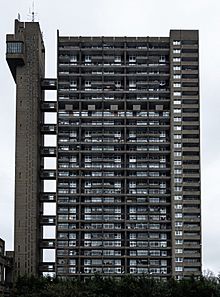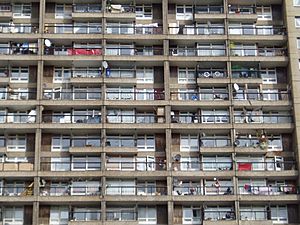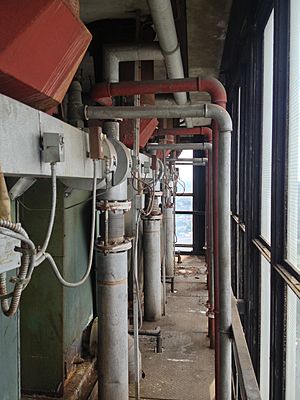Trellick Tower facts for kids
Quick facts for kids Trellick Tower |
|
|---|---|

Trellick Tower showing detail of the various apartments and separate access tower with abutting plant house
|
|
| General information | |
| Type | Residential flats |
| Architectural style | Brutalist |
| Location | Kensal Green, Royal Borough of Kensington and Chelsea, London |
| Coordinates | 51°31′25.6″N 00°12′19.8″W / 51.523778°N 0.205500°W |
| Completed | 28 June 1972 |
| Height | |
| Roof | 98 metres (322 ft) |
| Technical details | |
| Floor count | 31 |
| Design and construction | |
| Architect | Ernő Goldfinger |
| Designations | |
|
Listed Building – Grade II
|
|
| Official name: Trellick Tower | |
| Designated: | 22 December 1998 |
| Reference #: | 1246688 |
Trellick Tower is a famous tall building in London, England. It is a special type of building called a tower block. It was finished in 1972 and was designed by a famous architect named Ernő Goldfinger. The tower is known for its unique style called Brutalism, which uses a lot of concrete.
Trellick Tower was built to provide new homes for people. It was designed to be a follow-up to Goldfinger's earlier building, Balfron Tower, in East London. This was the last big project Goldfinger worked on. The building has many clever designs to save space. It also has a separate tower for lifts and services.
When the tower was new, tall concrete buildings were not very popular. But things got better for Trellick Tower in the 1980s. Residents formed a group to improve things. They added security and hired a concierge (a person who helps residents and looks after the building). This made the tower much safer. By the 1990s, Trellick Tower became a popular place to live. Most of the homes are still for people who need affordable housing. However, private flats are also in high demand.
Trellick Tower is an important local landmark. Since 1998, it has been a "Grade II* listed building." This means it is a very important historic building that must be protected. Its special concrete look has been kept because of this. In 2017, there was a fire, but the strong concrete structure meant the damage was not too bad. Trellick Tower has also appeared in many films and TV shows.
Contents
Where is Trellick Tower?
Trellick Tower is located in Kensal Green, in an area of London called the Royal Borough of Kensington and Chelsea. It is part of the Cheltenham Estate.
The building is surrounded by important landmarks. To the north and east, you can find the Grand Union Canal. To the south, there is the A40 Westway road and the main railway line from London Paddington station.
If you want to visit, the closest train stations are Kensal Green, Ladbroke Grove, and Westbourne Park. Many London Buses also stop nearby.
How Trellick Tower Was Designed
The main part of Trellick Tower is 98 metres (322 ft) tall. If you include the communications mast on top, it reaches 120 metres (394 ft). As a "Grade II* listed building," it is protected because of its special design and history.
The design of Trellick Tower is based on an earlier, slightly smaller building by Goldfinger called Balfron Tower. Trellick Tower has a long, thin shape. It has a separate tower next to it for lifts and services. This service tower is connected to the main building every three floors by walkways. The main building has 31 floors in total.
Some flats have internal stairs because they are split over two levels. For example, the 23rd and 24th floors have these "maisonettes." The building has 217 homes in total. When it was first built, the GLC owned the flats, and they were rented as council flats. Every apartment in the tower has its own balcony. There is also another smaller building nearby with shops and other facilities.
The service tower is two floors taller than the main building. It has a special "plant room" at the top. This room holds the main heating system for the building. Putting the heating system at the top means less pumping is needed. It also means the pipes are shorter, which helps save heat. The original heating system used oil, but this became old-fashioned after the 1973 oil crisis. Now, the flats use electric heaters. The old plant room is no longer used, but the equipment is still there.
Goldfinger designed the whole tower by hand. He planned different shared areas for people to use. He also made small changes to the structure so that each apartment would feel a bit different. He included many smart ways to save space. For example, bathrooms have sliding doors, and light switches are built into the door frames. All apartments have big windows facing the balconies. This lets in lots of natural light.
Besides homes, the tower complex also has shops, an office, and a youth centre. High-quality materials were used to build it. For instance, the balconies were finished with cedarwood. The goal was to create a great example of modern design for social housing.
History of Trellick Tower
Building the Tower
Work on Trellick Tower started in 1968. It was built to replace older, less suitable homes in the area. At first, people were happy about the tower. They saw it as a way to solve housing problems after the Second World War. Goldfinger believed that building tall towers would leave more ground space for children and adults to enjoy.
Goldfinger was encouraged to build Trellick Tower by the London County Council (LCC). This was after his success with Balfron Tower, which opened in 1967. He learned from Balfron Tower. He even lived in an apartment there to understand what life would be like for the residents. He invited residents to parties to hear their ideas. This feedback helped him design Trellick Tower. Many people from the Caribbean moved into Trellick Tower. It was one of the few affordable places to live in London for them. The tower officially opened on June 28, 1972. It was Goldfinger's last big project.
Challenges and Changes
By the time Trellick Tower opened, tall concrete buildings were becoming less popular. The council that started the project, the LCC, was replaced by the Greater London Council (GLC). The GLC put more rules on the building project. Soon after it was finished, the building was given to the local council, RBKC. Goldfinger wanted the building to have good security and a concierge. He asked the council for this, but they said no. Even the drying rooms on the ground floor, meant for laundry, were damaged before the tower opened.
In the late 1970s, Trellick Tower faced some problems. Many people did not want to move in.
A New Beginning
Over time, residents were given the chance to buy their council homes. On October 8, 1984, a new group of residents was formed. Because of their efforts, many security improvements were made. An intercom system was installed, and a concierge was hired in 1987. In 1994, residents decided to manage their own properties. This helped them avoid higher rents and the risk of losing their homes.
In 1989, small TV transmitters were added to the top of the lift tower. This helped improve TV reception for people living in nearby areas like Notting Hill.
In 1991, an architecture professor named Sand Helsel made a TV show praising Trellick Tower. This helped change how people viewed the building. The tower became more respected. Its location near Notting Hill and the improvements in Golborne Road also helped. Property prices went up, and flats in the tower became very popular. People started putting notes on the tower's noticeboard asking to buy flats. By 1999, a flat could sell for £150,000. In 2013, a three-bedroom flat was rented for £2,600 a month.
The tower is now a local landmark. It was given a "Grade II* listing" in 1998. This protects the main building and the nearby shops. A doctor's office with its original design is also included. Most of the flats are still social housing, but many are now privately owned.
On April 19, 2017, a fire broke out on the top floors of the tower. It was thought to have started from a discarded cigarette. Luckily, no one was hurt. Because the building is listed, its concrete outside could not be covered up. This is believed to have stopped the fire from becoming much worse, unlike the Grenfell Tower fire that happened a few months later.
See also
 In Spanish: Trellick Tower para niños
In Spanish: Trellick Tower para niños




